Plecos and Red Tail Sharks are both favored selections for freshwater tanks. Yet, can they cohabit peacefully in one aquarium?
What are the essential considerations if you’re thinking of housing them together? How should you address the tank arrangements, water conditions, and dietary practices of both?
Which Pleco varieties mesh well with Red Tail Sharks, and which ones might not be the best fit? And who else can join the aquatic party?
Dive into this guide as I tackle these topics. Let’s get started.
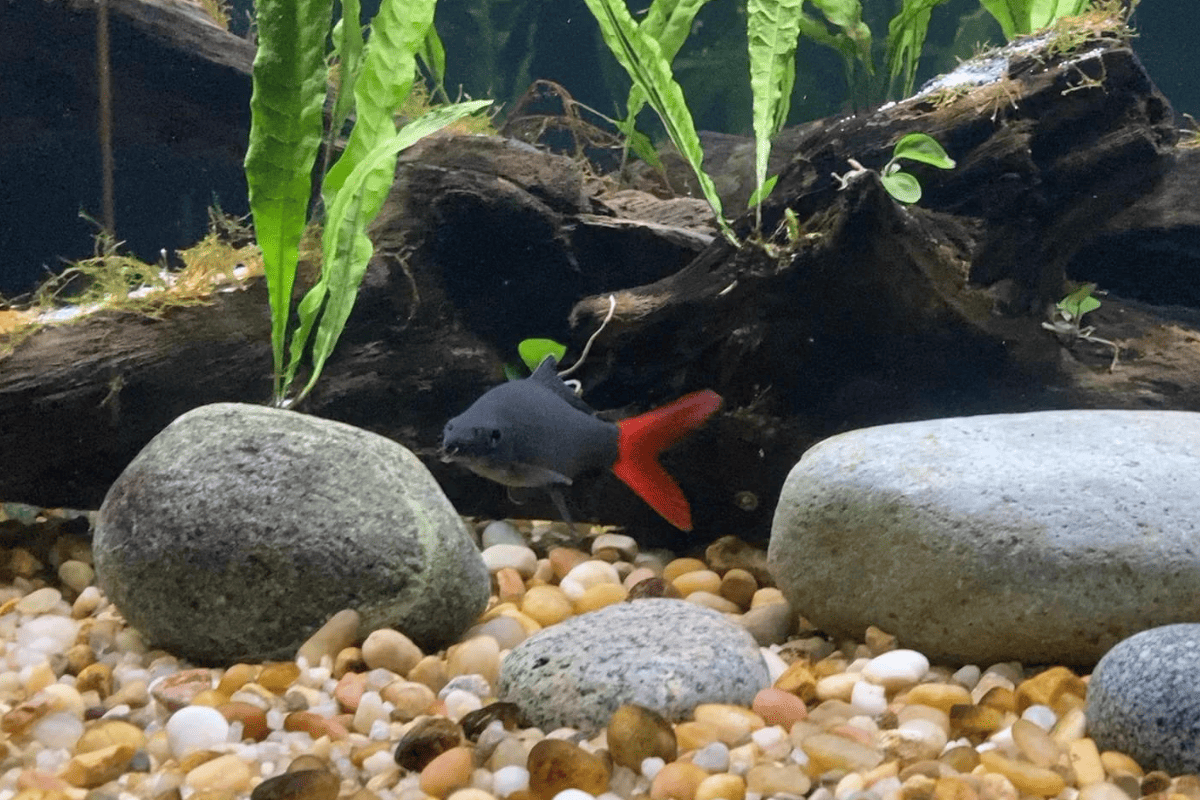
Can I Keep Plecos and Red Tail Sharks Together in the Same Tank?
Yes, Plecos and Red Tail Sharks can be kept together in the same tank. However, there are important considerations to ensure their coexistence.
- Dietary Needs: Plecos are primarily herbivores, munching on algae and veggies, while Red Tail Sharks eat a mix of plant-based and protein-rich foods. This distinction reduces direct food competition.
- Size and Space: Plecos can grow up to 24 inches, depending on the species, and Red Tail Sharks around 6 inches. Adequate tank space is essential to avoid territorial disputes.
- Temperament: Red Tail Sharks can be territorial, especially as they mature. Plecos, being mostly bottom dwellers, might inadvertently intrude upon a Red Tail Shark’s claimed space.
- Habitat Structure: Both species prefer hiding spots. Plecos need driftwood or caves, and Red Tail Sharks prefer dense plants and rocks. A well-structured tank can reduce conflicts.
- Environmental Needs: Plecos and Red Tail Sharks share similar water parameters – a temperature range of 72-79°F and a pH of 6.5-7.5. This compatibility ensures that both can thrive in the same conditions.
Also Read: Pleco Fish Tank Mates
Plecos vs. Red Tail Sharks: Behavior
The first factor worth considering is the Plecos’ and Red Tail Sharks’ natural behavior. Here is what you should know:
Pleco Fish: Natural Behavior
Plecos are calm, nocturnal bottom dwellers, usually focused on algae consumption. They’re mostly peaceful but can show territoriality, especially during breeding.
- Nocturnal Activities: Plecos tend to roam and feed during nighttime, often resting or hiding during the day.
- Dietary Preferences: With a sucker-shaped mouth, Plecos are efficient at consuming algae, keeping tanks cleaner.
- Space Ownership: During breeding, male Plecos defend their nesting sites from other fish, signaling territorial behavior.
- Seeking Shelter: Driftwood, caves, and similar structures are favored by Plecos for daytime retreats and rest.
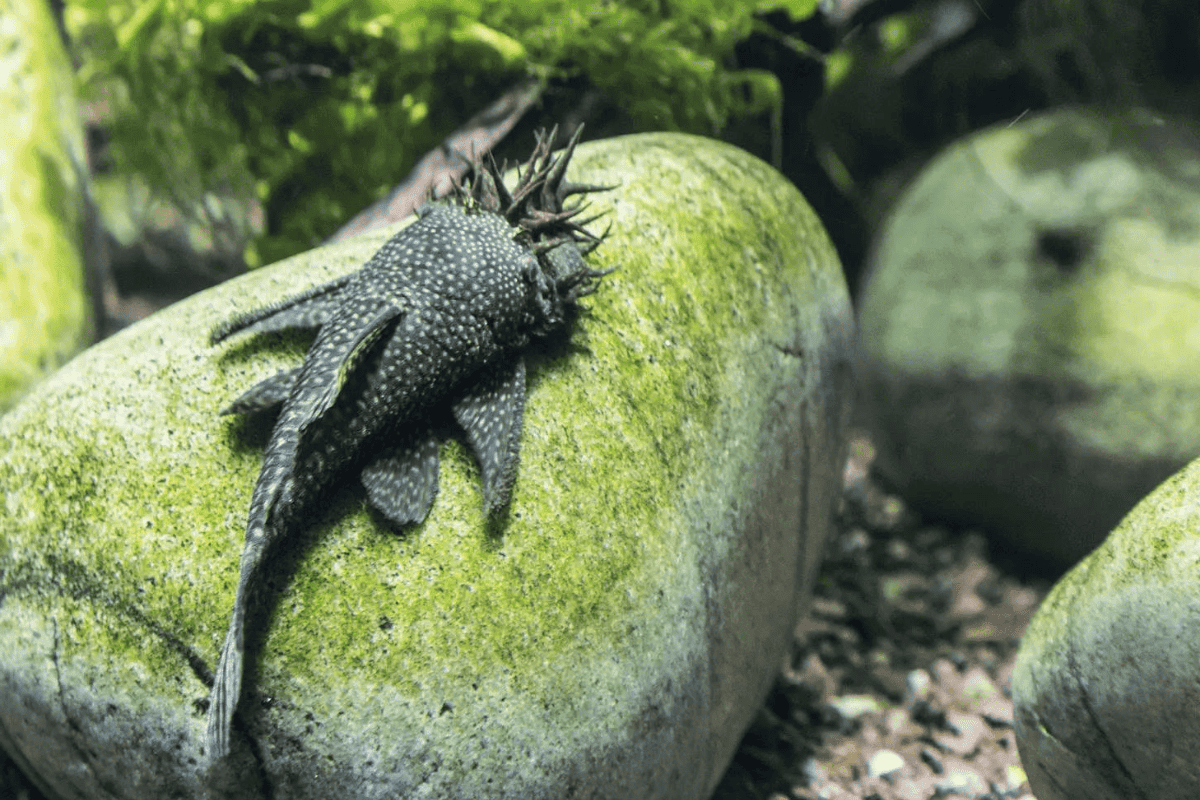
Red Tail Shark: Natural Behavior
Red Tail Sharks are lively, mid-to-bottom dwellers, known for their territorial nature. They are primarily solitary fish, with striking coloration that sets them apart.
- Lone Sharks: Red Tail Sharks are often solitary and might chase away other fish from their territories.
- Territorial Displays: These fish frequently claim specific areas, especially caves or plants, and defend them.
- Omnivorous Diet: Red Tail Sharks balance their diet between plant materials and protein sources, showcasing flexibility.
- Active Swimmers: With their slender bodies, Red Tail Sharks frequently patrol their territories, making them more visible in tanks.
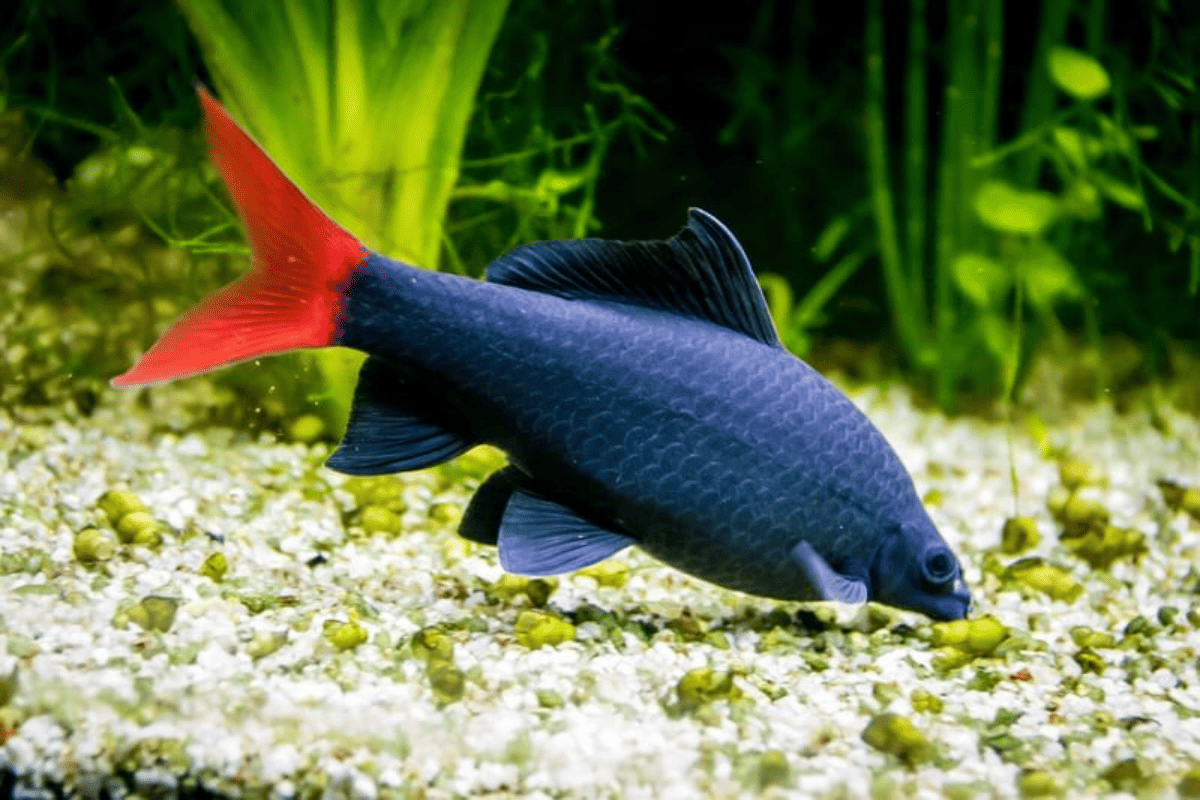
Ideal Parameters for Plecos and Red Tail Sharks
When managing an aquarium with Plecos and Red Tail Sharks, maintaining the ideal water parameters ensures the health and well-being of both species.
Here’s a comparison of their preferred conditions:
| Parameters | Plecos | Red Tail Sharks | Both Types |
| Temperature (°C) | 22-30 | 22-28 | 22-28 |
| pH Level | 6.5-7.5 | 6.8-7.5 | 6.7-7.5 |
| Water Hardness (dGH) | 4-15 | 5-15 | 5-15 |
Pleco Fish: Ideal Parameters
Plecos, originating from warm freshwater habitats, require specific conditions for optimum health. They prefer stable water parameters that mimic their natural habitats.
- Temperature: Plecos thrive best in water temperatures ranging from 72°F to 82°F, ensuring their metabolism functions properly.
- pH Levels: Neutral to slightly acidic water is ideal, with pH levels between 6.5 to 7.5 being the sweet spot.
- Water Hardness: Soft to moderately hard water, with dGH between 4 to 20, is ideal for Plecos to flourish.
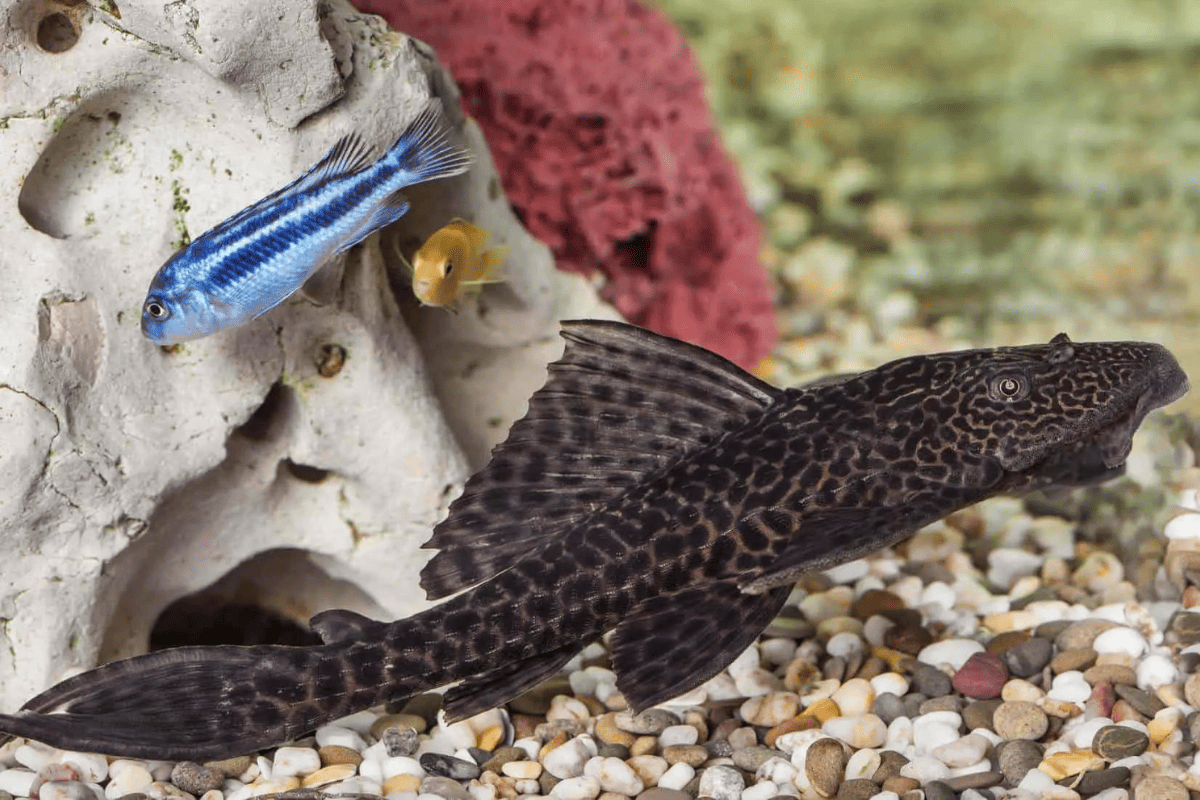
Red Tail Shark: Ideal Parameters
Red Tail Sharks, native to Thailand’s freshwater rivers, have specific water requirements. Providing these conditions ensures their health and vibrancy.
- Temperature: A range of 72°F to 79°F is most conducive for Red Tail Sharks, resembling their tropical origins.
- pH Levels: They prefer slightly acidic to neutral water, with pH readings from 6.5 to 7.5 being optimal.
- Water Hardness: Moderately soft to slightly hard water, within the dGH range of 5 to 15, best suits Red Tail Sharks.
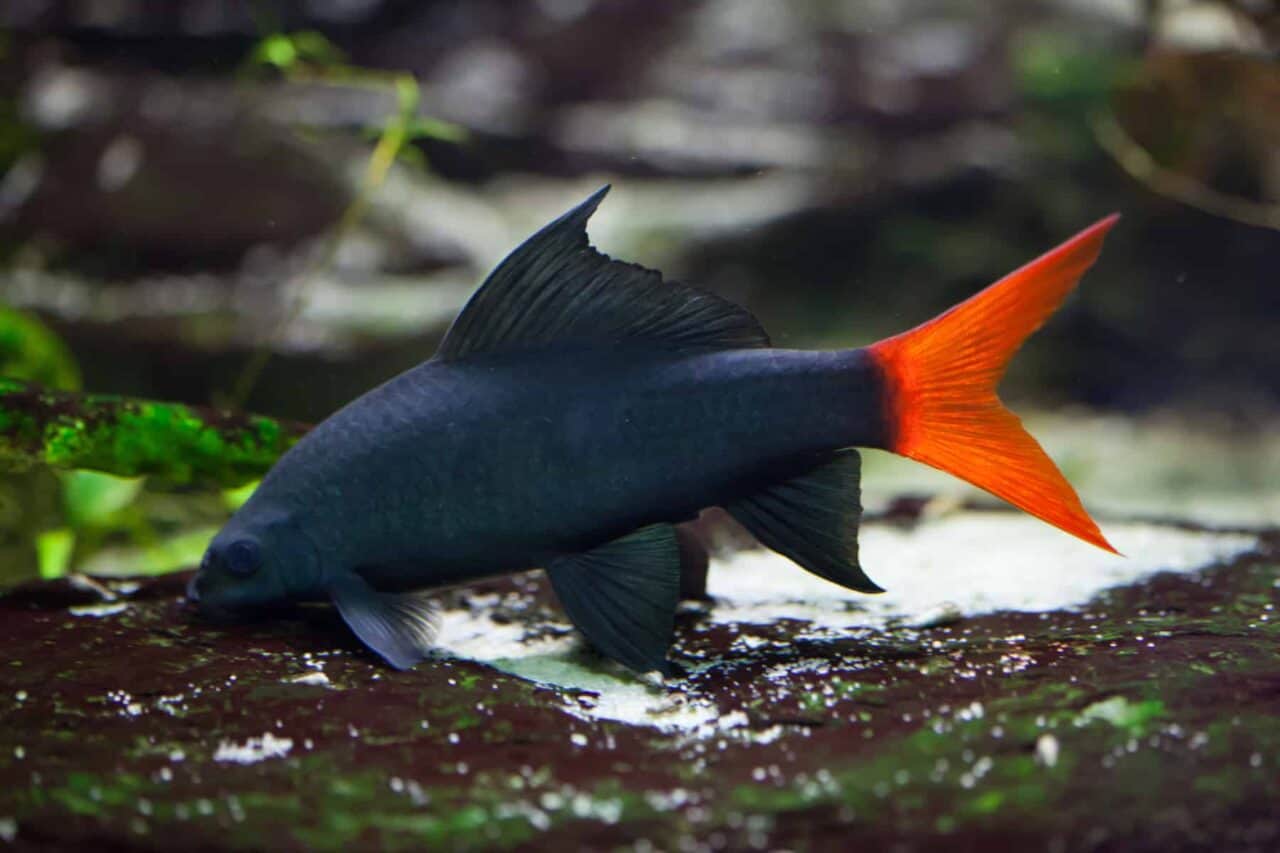
Plecos vs. Red Tail Sharks: Tank Setup
Tank setup is critical to ensure a harmonious environment, especially in a shared tank. Here’s a breakdown of the essential requirements for each species:
| Tank Setup | Plecos | Red Tail Sharks | Both Types |
| Ammonia | 0 ppm | 0 ppm | 0 ppm |
| Nitrite | 0 ppm | 0 ppm | 0 ppm |
| Nitrate | Below 30 ppm | Below 20 ppm | Below 20 ppm |
| Tank Size | Min. 40 gallons | Min. 55 gallons | Min. 75 gallons |
| Foliage | Thick plant coverage | Moderate plants | Thick to moderate plants |
| Decorations | Driftwood, caves | Rocks, caves | Caves, driftwood, rocks |
| Filter | Strong flow | Moderate flow | Strong flow |
| Heater | Necessary | Necessary | Necessary |
| Substrate | Fine to medium gravel | Sand or fine gravel | Fine to medium gravel |
| Lighting | Moderate | Moderate to low | Moderate |
Pleco Fish: Tank Setup
Plecos, given their size and natural behavior, require a carefully planned tank environment. They’re large fish that love to hide and need specific conditions to flourish.
- Ammonia Nitrite Nitrate: Maintaining zero ammonia and nitrite levels, with nitrates less than 20 ppm, is crucial for Plecos’ health.
- Tank Size: Due to their potential size, Plecos demand large tanks. A minimum of 55 gallons is recommended, but bigger is always better.
- Foliage: Broad-leafed plants provide resting spots for Plecos, offering shelter and security.
- Decorations: Caves and driftwood are essential, mimicking natural hiding places and allowing space for resting.
- Filter: A robust filtration system is key, ensuring the tank remains clean and free of detritus.
- Heater: Keeping water temperatures between 72°F to 82°F is ideal, thus a reliable heater is vital.
- Substrate: Sand or fine gravel, which doesn’t injure Plecos’ soft underbellies, is preferred.
- Pump: Adequate water circulation is vital for Plecos, so ensure a pump that creates gentle currents.
- Lighting: Dimmed or moderate lighting, replicating their natural habitats, is perfect for Plecos.
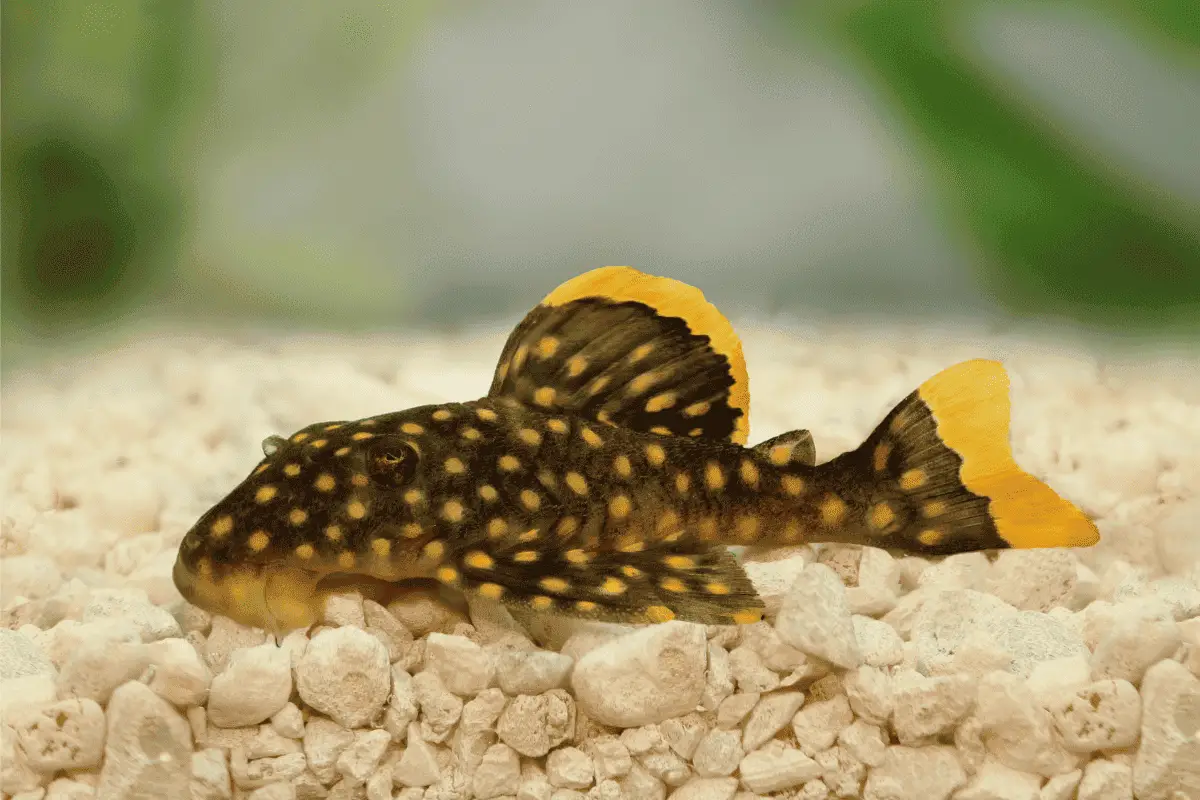
Red Tail Shark: Tank Setup
Red Tail Sharks are active and territorial, necessitating a tank setup that caters to their behavioral traits.
They’re vibrant fish that require specific elements to exhibit natural behaviors.
- Ammonia Nitrite Nitrate: Just like Plecos, Red Tail Sharks need ammonia and nitrite at zero, with nitrates below 20 ppm.
- Tank Size: For these active swimmers, a minimum of 55 gallons is crucial, allowing room for territories.
- Foliage: Dense plants provide hiding spots and territorial boundaries for Red Tail Sharks.
- Decorations: Rocks and caves are essential, offering them safe territories and resting places.
- Filter: A strong filter helps in keeping the water clear and removes waste efficiently.
- Heater: Ensuring temperatures of 72°F to 79°F is key for the Red Tail Shark’s well-being.
- Substrate: Fine gravel, allowing them to sift, is the ideal substrate choice for these fish.
- Pump: A pump that ensures moderate water circulation complements the Red Tail Shark’s natural behavior.
- Lighting: Moderate lighting is best, bright enough to showcase their colors but not too intense to stress them.
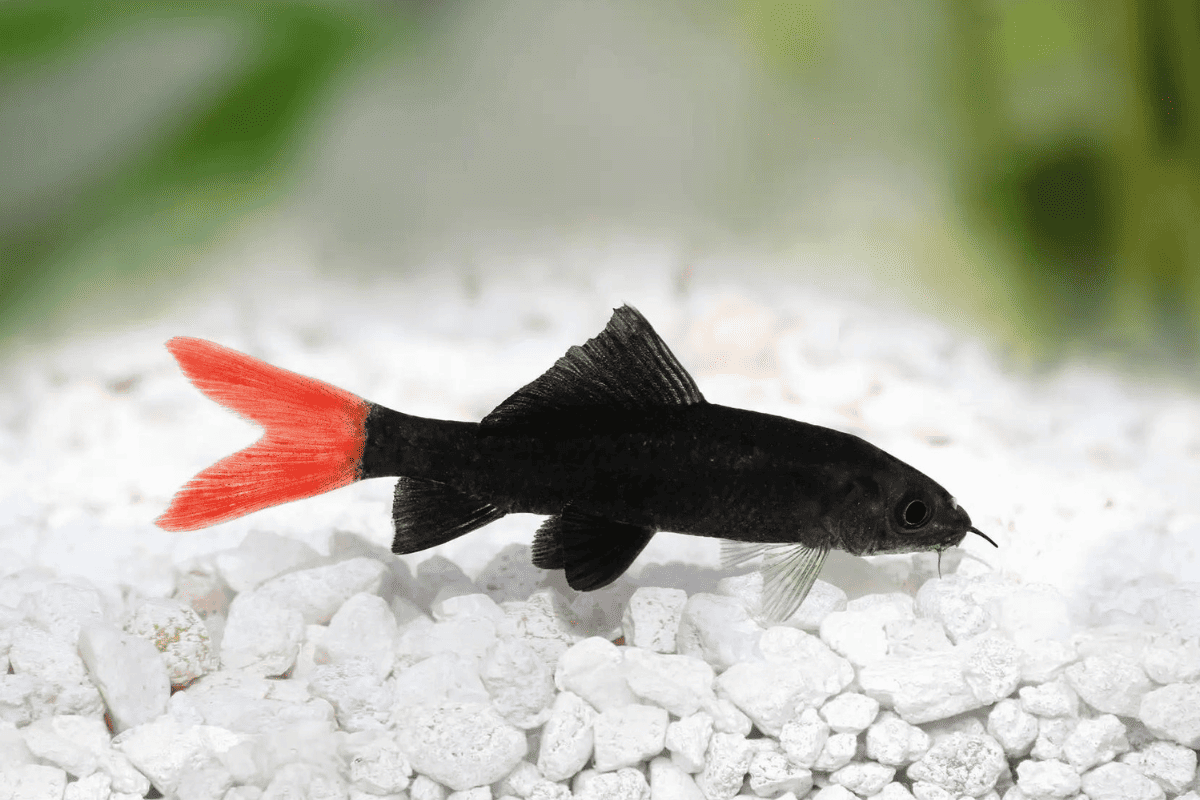
The Dietary Requirements of Plecos and Red Tail Sharks
Both Plecos and Red Tail Sharks have specific dietary needs to ensure they remain healthy and vibrant. Here’s a quick guide to their feeding requirements:
| Dietary Needs | Plecos | Red Tail Sharks | Both Types |
| Food Types | Algae wafers, veggies, worms | Omnivorous diet | Algae wafers, omnivorous |
| Quantity | Varies by species/size | 2-3% body weight | Adjusted for combined stock |
| Feeding Schedule | 2-3 times daily | Once daily | 2-3 times daily |
Pleco Fish: Ideal Dietary Requirements
Plecos, with their unique mouth structure, have specific dietary needs, primarily revolving around vegetation.
They are primarily herbivores, but occasionally appreciate protein-rich foods.
- Food Types: Algae wafers, blanched vegetables (like zucchini), and sinking pellets are staples in a Pleco’s diet.
- Quantity: Ensure enough food that Plecos can consume within 2-3 hours to avoid overfeeding.
- Feeding Schedule: Daily feedings, preferably in the evening (due to their nocturnal nature), work best for Plecos.
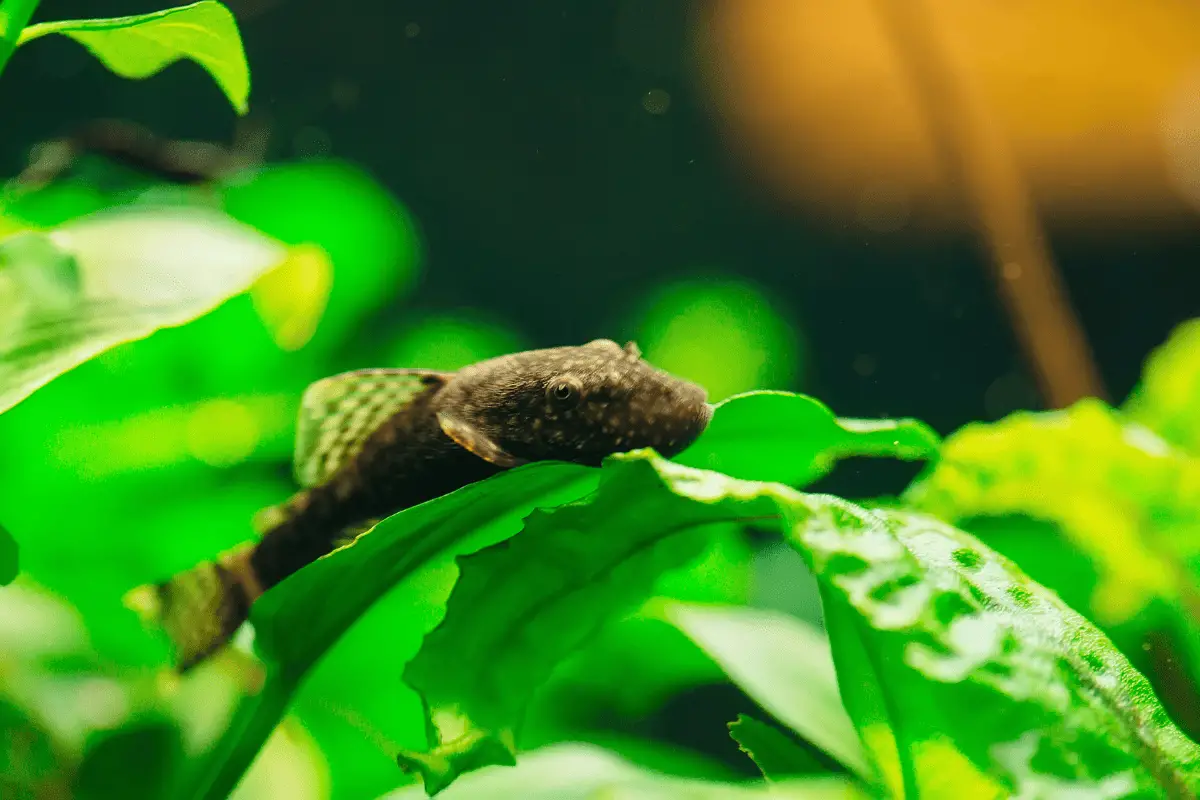
Red Tail Shark: Ideal Dietary Requirements
Red Tail Sharks, being omnivorous, require a balanced diet of both plant and protein sources. A varied diet helps in keeping them healthy and vibrant.
- Food Types: Flakes, sinking pellets, brine shrimp, and plant materials cater to their varied palate.
- Quantity: Feed in amounts they can consume within 3-5 minutes to prevent leftover food.
- Feeding Schedule: Feeding them once or twice a day, ensuring consistency, keeps them active and healthy.
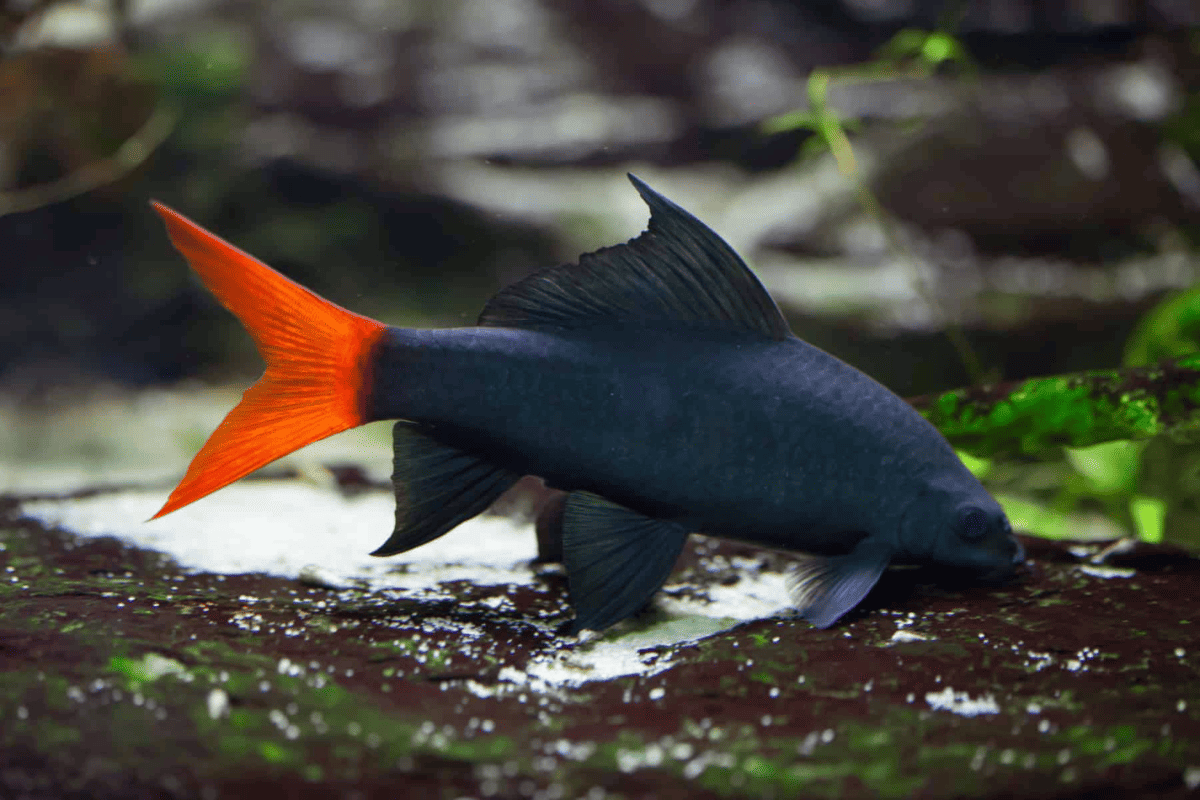
Pleco Species Most Suitable for a Tank With Red Tail Sharks
When considering Plecos to house with Red Tail Sharks, it’s best to opt for smaller, peaceful species.
These Plecos are less likely to compete for territory and will peacefully coexist with the Red Tail Sharks.
- Bristlenose Plecos: Growing to only 4-6 inches, Bristlenose Plecos are a perfect size and have a calm temperament, ideal for community tanks.
- Clown Plecos: Another small variety, Clown Plecos typically grow up to 4 inches and have a peaceful nature, making them suitable tankmates.
- Rubber Lip Plecos: With a max size of around 7 inches, Rubber Lip Plecos are not overly large and maintain a peaceful disposition in tanks.
- Zebra Plecos: Rare and attractive, Zebra Plecos grow up to 3-4 inches, ensuring they don’t intrude into Red Tail Shark territories.
- Dwarf Plecos: As the name suggests, these Plecos stay small, around 3-4 inches, and their placid nature complements Red Tail Sharks.
Also Read: Can Plecos And Rainbow Sharks Live Together?
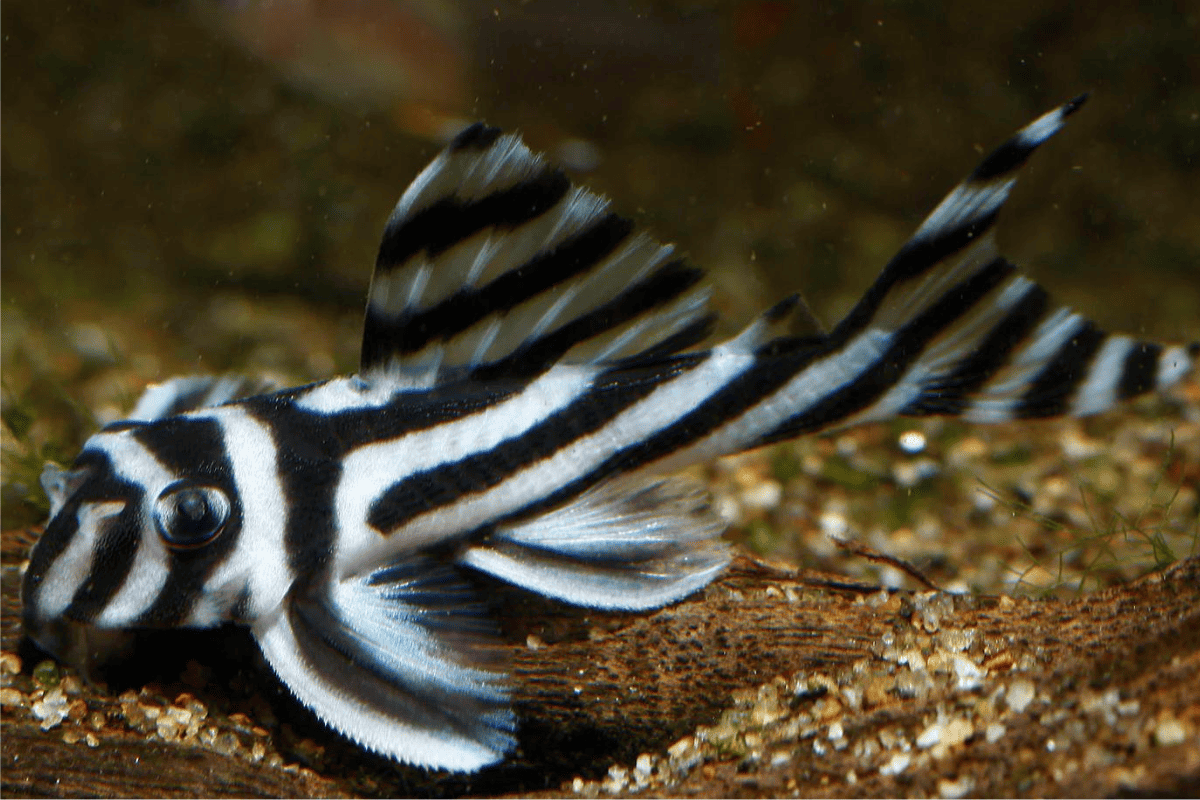
Which Pleco Types Shouldn’t Be Kept with Red Tail Sharks?
Certain larger and more territorial Pleco species might clash with Red Tail Sharks in the confines of an aquarium.
It’s best to avoid species that can become aggressive or overly dominant.
- Common Plecos: Growing up to 24 inches, Common Plecos can become quite territorial, potentially causing tension in the tank.
- Sailfin Plecos: These Plecos can reach lengths of 18 inches, and their size alone can lead to territorial disputes with Red Tail Sharks.
- Royal Plecos: Growing up to 17 inches, Royal Plecos can be assertive, especially when defending their chosen hiding spots.
- Vampire Plecos: Though captivating, Vampire Plecos, reaching 10 inches, might compete too aggressively for territory.
- Gulper Plecos: A larger species that can grow beyond 12 inches, Gulpers can be territorial, potentially clashing with the more assertive Red Tail Sharks.
How to Introduce Your Pleco to a Tank with Red Tail Sharks
Introducing your Pleco to a Red Tail Shark tank requires careful planning and patience. Doing so correctly ensures both species feel comfortable and reduce potential aggression.
- Quarantine First: Always keep your new Pleco in a separate tank for 2-3 weeks, ensuring it’s disease-free before the primary introduction.
- Adjust Lighting: Dim the aquarium’s lights to about 50% brightness; this subdued environment can reduce initial territorial behaviors.
- Floating Method: Float the Pleco (inside a bag) in the main tank for about 30-45 minutes, equalizing the water temperature.
- Use a Barrier: For the first few days, use a tank divider or mesh to separate them, allowing visual but not physical interaction.
- Monitor Behavior: Observe closely for the initial 72 hours, ensuring no aggressive chases or territorial disputes emerge.
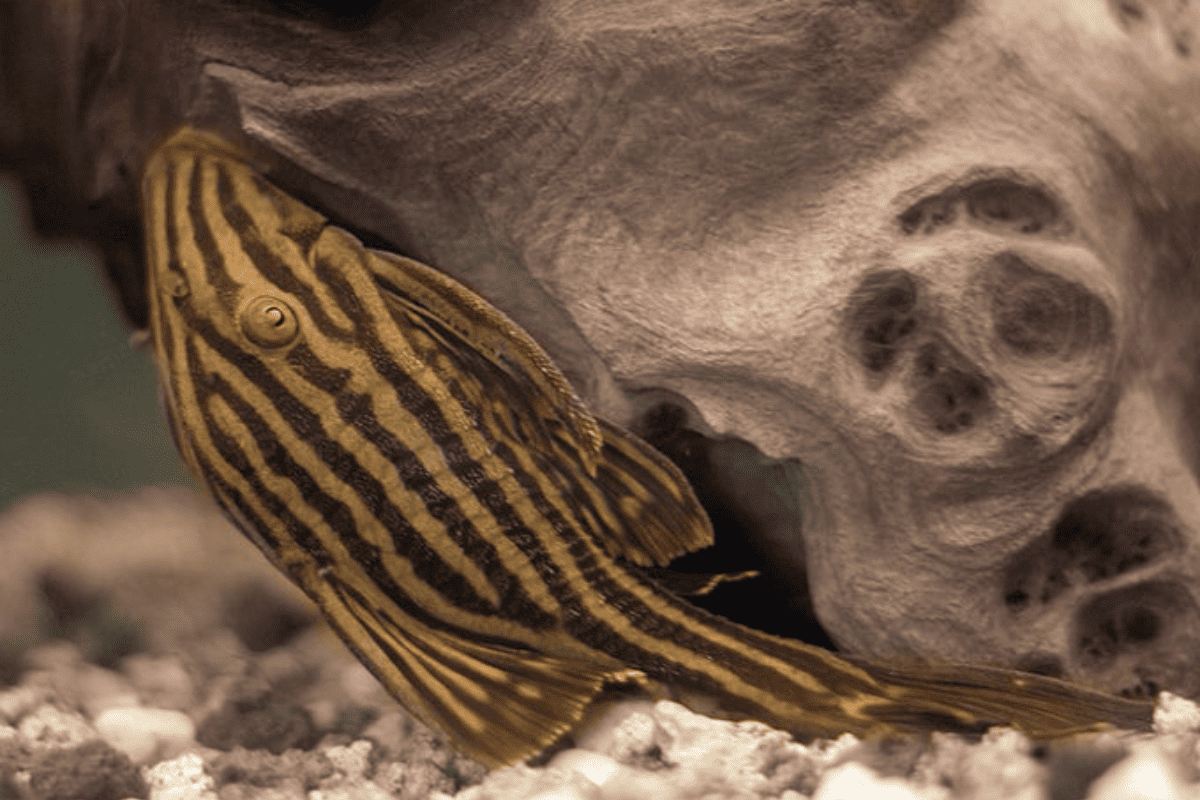
Tips for Keeping Plecos with Red Tail Sharks
To successfully keep Plecos with Red Tail Sharks, certain management techniques ensure a harmonious tank environment.
By catering to each species’ needs, you can promote coexistence.
- Tank Size: Opt for at least a 55-gallon tank, but preferably larger, allowing both species ample space and territory.
- Hideouts are Crucial: Install multiple caves, driftwood, or hideouts. Plecos need these to feel secure and to rest. My recommendation: Dr. Moss Malaysian Driftwood (link to Amazon).
- Feed Separately: Drop food at different ends of the tank, minimizing competition during feeding times.
- Regular Monitoring: Observe your fish daily, ensuring no signs of stress, disease, or excessive territorial behavior.
- Enrich Environment: Diverse decorations, plants, and hiding spots can diffuse aggression by breaking lines of sight.
- Maintain Water Quality: Regularly test water parameters, aiming for ammonia and nitrite at 0 ppm, and nitrate below 20 ppm. I check those with the well-known API FRESHWATER MASTER TEST (link to Amazon).
- Avoid Overstocking: Limit the number of fish. Overcrowding can escalate territorial behaviors and stress.
Best Tank Mates for Plecos and Red Tail Sharks
When pairing tank mates with Plecos and Red Tail Sharks, the key is to choose non-aggressive species that won’t invade the territories of either fish.
Compatibility ensures a peaceful and vibrant community tank.
- Danios: Fast-swimming and hardy, Zebra Danios, for instance, stay in the upper water levels, avoiding Pleco and Red Tail Shark territories.
- Tetras: Cardinal and Neon Tetras are peaceful mid-water dwellers, unlikely to provoke Plecos or Red Tail Sharks.
- Gouramis: Dwarf Gouramis or Pearl Gouramis are calm species that tend to stay out of the way of bottom-dwellers like Plecos.
- Corydoras Catfish: Peaceful and sociable, Corydoras scour the bottom without infringing on Pleco or Red Tail Shark spaces.
- Rasboras: Harlequin Rasboras, with their peaceful demeanor, occupy mid-water levels and complement both Plecos and Red Tail Sharks.
- Barbs: Cherry Barbs or Golden Barbs are compatible; however, avoid Tiger Barbs as they might nip at Plecos’ fins.
Also Read: Can Plecos And Barbs Live Together?
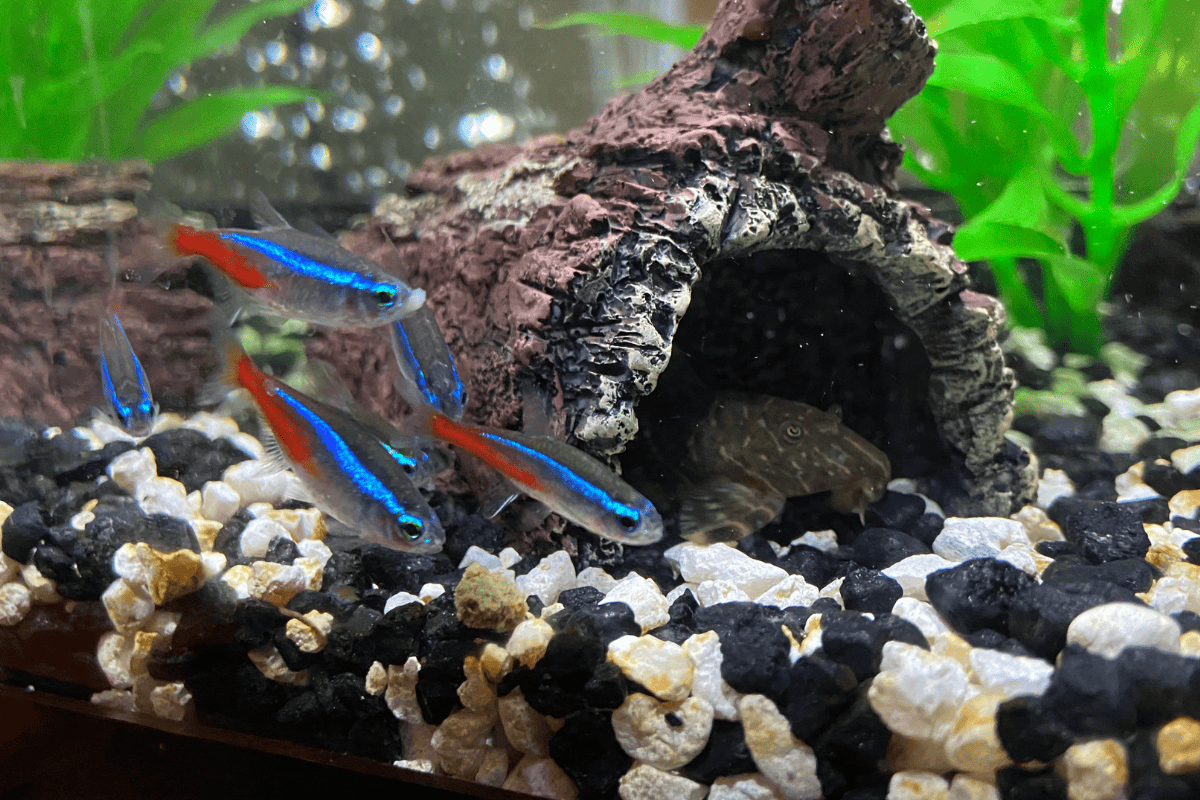
Conclusions
For those of you who are just skimming through, here’s a short recap:
- Plecos and Red Tail Sharks can coexist in a tank if the environment and parameters are closely monitored.
- The ideal tank setup caters to the needs of both species, especially in terms of hiding spots and tank size.
- Dietary considerations for both species are vital for their health and harmony within the tank.
- Certain Pleco species are more suitable for living with Red Tail Sharks, while others should be avoided.
- Apart from Plecos and Red Tail Sharks, several other fish species can serve as harmonious tank mates.
